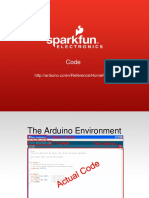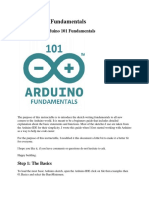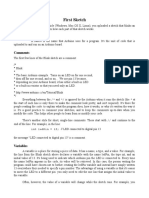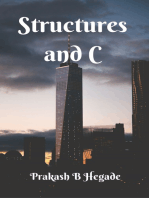0 ratings0% found this document useful (0 votes)
5 viewsProgramming Arduino (1) Pages 45
Uploaded by
axl1994Copyright
© © All Rights Reserved
Available Formats
Download as PDF, TXT or read online on Scribd
0 ratings0% found this document useful (0 votes)
5 viewsProgramming Arduino (1) Pages 45
Uploaded by
axl1994Copyright
© © All Rights Reserved
Available Formats
Download as PDF, TXT or read online on Scribd
You are on page 1/ 1
functions so that the Arduino system itself can call them.
This is a difficult
concept to grasp, but one way to think of it is as being similar to a definition in a
legal document.
Most legal documents have a “definitions” section that might say, for
example, something like the following:
Definitions.
The Author: The person or persons responsible for creating the book
By defining a term in this way—for example, simply using the word
“author” as shorthand for “The person or persons responsible for creating the
book”—lawyers can make their documents shorter and more readable. Functions
work much like such definitions. You define a function that you or the system
itself can then use elsewhere in your sketches.
Going back to void , these two functions (setup and loop ) do not return a
value as some functions do, so you have to say that they are void, using the void
keyword. If you imagine a function called sin that performed the trigonometric
function of that name, then this function would return a value. The value
returned to use from the call would be the sine of the angle passed as its
argument.
Rather like a legal definition uses words to define a term, we write functions
in C that can then be called from C.
After the special keyword void comes the name of the function and then
parentheses to contain any arguments. In this case, there are no arguments, but
we still have to include the parentheses there. There is no semicolon after the
closing parenthesis because we are defining a function rather than calling it, so
we need to say what will happen when something does call the function.
Those things that are to happen when the function is called must be placed
between curly braces. Curly braces and the code in between them are known as a
block of code, and this is a concept that you will meet again later.
Note that although you do have to define both the functions setup and loop ,
you do not actually have to put any lines of code in them. However, failing to
add code will make your sketch a little dull.
You might also like
- Brian Evans - Arduino Programming Notebook100% (1)Brian Evans - Arduino Programming Notebook36 pages
- Building Serverless Apps with Azure Functions and Cosmos DB: Leverage Azure functions and Cosmos DB for building serverless applications (English Edition)From EverandBuilding Serverless Apps with Azure Functions and Cosmos DB: Leverage Azure functions and Cosmos DB for building serverless applications (English Edition)No ratings yet
- Worksheet 3 Quarter 3 Robotics and ElectronicsNo ratings yetWorksheet 3 Quarter 3 Robotics and Electronics7 pages
- Electronics Section Iit Roorkee: Lecture On: Basics of ArduinoNo ratings yetElectronics Section Iit Roorkee: Lecture On: Basics of Arduino54 pages
- Arduino: Lenguaje de Implementación: Lic. Jorge Guerra GuerraNo ratings yetArduino: Lenguaje de Implementación: Lic. Jorge Guerra Guerra52 pages
- Arduino: Lenguaje de Implementación: Lic. Jorge Guerra GuerraNo ratings yetArduino: Lenguaje de Implementación: Lic. Jorge Guerra Guerra52 pages
- Intro To Coding With Arduino: Sunday, February 12, 2012100% (1)Intro To Coding With Arduino: Sunday, February 12, 201211 pages
- 1.1 Arduino Duemilanove: Mini Project Report 8-Bit RISC Microprocessor Using VHDLNo ratings yet1.1 Arduino Duemilanove: Mini Project Report 8-Bit RISC Microprocessor Using VHDL9 pages
- 3 Arduino Programming - 15march2022 - FinalNo ratings yet3 Arduino Programming - 15march2022 - Final38 pages
- ATL Arduino Homework Activity Workbook - Prof. Dattaraj Vidyasagar Vidyasagar AcademyNo ratings yetATL Arduino Homework Activity Workbook - Prof. Dattaraj Vidyasagar Vidyasagar Academy34 pages
- Coding Languages: Angular With Typescript, Machine Learning With Python And React JavascriptFrom EverandCoding Languages: Angular With Typescript, Machine Learning With Python And React JavascriptNo ratings yet
- Mastering Node.js Web Development: Go on a comprehensive journey from the fundamentals to advanced web development with Node.jsFrom EverandMastering Node.js Web Development: Go on a comprehensive journey from the fundamentals to advanced web development with Node.jsNo ratings yet
- Spring Boot and Single-Page Applications: Securing Your API with a Single-Page Application Frontend - Second EditionFrom EverandSpring Boot and Single-Page Applications: Securing Your API with a Single-Page Application Frontend - Second EditionNo ratings yet
































































